Back to School?
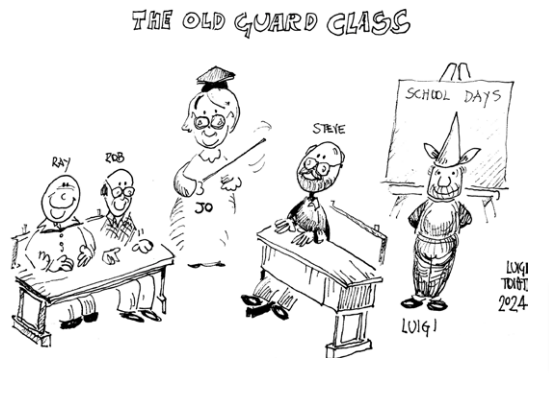
Schoolrooms – good or bad memories for all of us? Maybe that question is how or why “kids in school” ended up in my collection. Like most adult collectors I played with toy soldiers as a boy: Dimestores, hollowcasts, composition, and plastics. A lot of these were running and shooting various weapons; strangely it seemed that the most expensive just marched or sat on horses.
As an adult, however, I discovered that unlike many of my other toys my soldiers hadn’t gone to the rummage sale. Some like my old ones were still for sale at a garage sale down the block and at the flea market and eventually at old toy soldier shows. There were soldiers I’d had or wanted as a child and plenty of figures I’d never seen before. I collected those, plus “big surprises” that were doing things: fixing roads, delivering milk or watching zebra at the zoo; or, yes, even teaching school.
Well, schoolrooms were not the start of my concentration on collecting civilian figures. Over the years I have collected many makers Boy Scouts, railroad passengers, and scores of figures doing similar familiar things.
Sometimes only one or two companies created an airport or cast a soccer team or made a man lighting a streetlamp. Recently, I’ve been thinking about the uniqueness of some civilian figures, and the commonality of others. In that light I realized that I had several schoolroom sets on my shelf, and I’d seen others in collections. In some ways they were very different and still so much the same. These sets are good reminders of the pasts we had or didn’t have in our childhoods. They also show common experiences across time and place despite some significant differences. So these metal toy schoolroom
sets are an historical and cultural sample of this, in or out of the box.
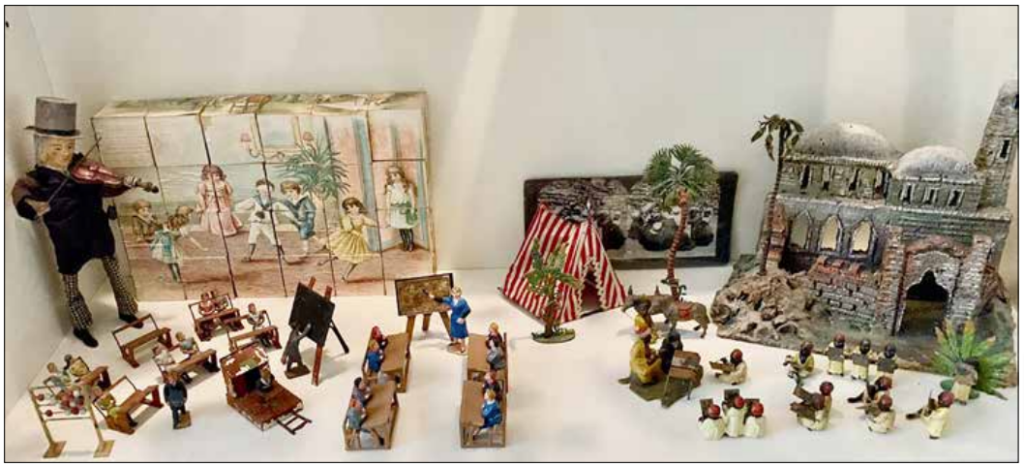
Heyde Girls Schoolroom
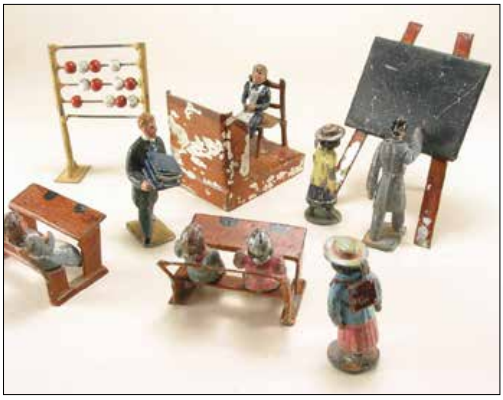
School classroom sets reveal a lot about the cultures they represent. Typical is one from Heyde, Germany’s greatest maker of solidcast metal figures. This set, The School #1314 , represents an all-girls classroom. There are nine solid cast figures seated at typically Heyde tin desks. Eight of these 48mm figures wear brightly colored dresses with white aprons often seen in pre-1920s classrooms. One of these girls wears a black dress with a white apron, perhaps representing a class monitor seated at the raised tin teacher’s desk. There are also two adult male teachers; one carries folded tin “books” and the other with a moveable right arm is standing at the tin blackboard. There is also a larger than life, cast abacus. This seems to be the complete set. There are, however, additional walking Heyde school girls that were purchased with the set. These girls carry books or backpacks like girls on their way to school.
Whether these figures were sold with the set or were originally from a Heyde park or playground set and then added, is not clear. It is probably the latter suggests Heyde expert Markus Grein. His research reveals that The School set was listed in the 1909 Heyde catalog, but was not in the 1926 catalog; the Set was probably made between 1890 and 1905. The painting of the girls, probably from the playground set, indicates a date before the turn of the 19th century for those figures.
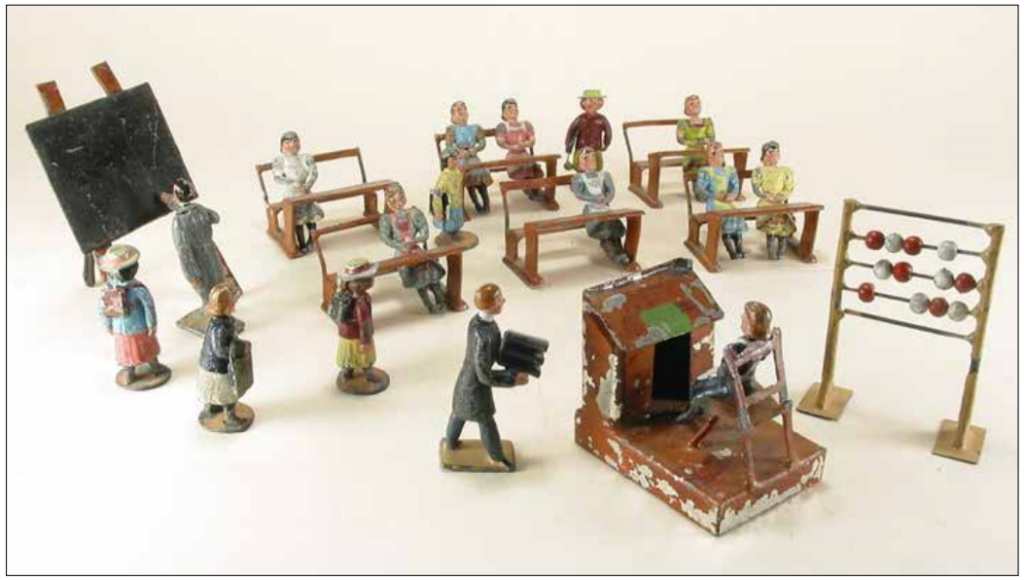
Heyde Arab Middle Eastern School
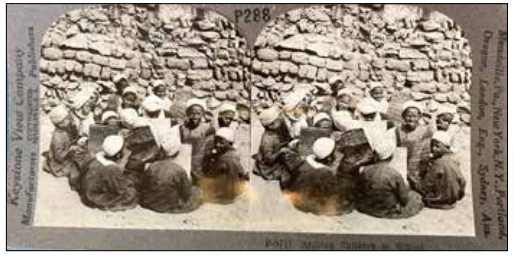
This Middle Eastern school employs heavy metal, solid cast figures in approximately 6 cm scale. They are Heyde Nippies sold as part of Heyde’s set #1458; the Arab Market. Similarly painted figures in various poses and several sizes are not uncommon.
This school set scene probably reflects popular interest in Middle Eastern-Arab culture stimulated by archaeology and exploration in the Middle East from the 19th century into the Egyptian discoveries of the 1920’s. The set also closely resembles a turn
of the century product, a Keystone Co. stereo 3D slide entitled “Arabian Children at School”. The back of the cardboard side introduces the young viewer to the Koran “in faraway Egypt” compared to Western schools and books (see the accompanying image).
The Heyde students are either cast as a single figure or soldered together into a group and then painted. Each student holds a separate piece of tin representing a page of writing; no writing remains on the tin. These school figures include the male teacher reading and a woman in blue wearing a Niqab plus a full wrap gown. Not original but added to the scene is the red and white striped tent, the man with donkeys, and the foliage. The Middle Eastern building is made of a type of paper mâché. They are from several sources, but they set the scene.
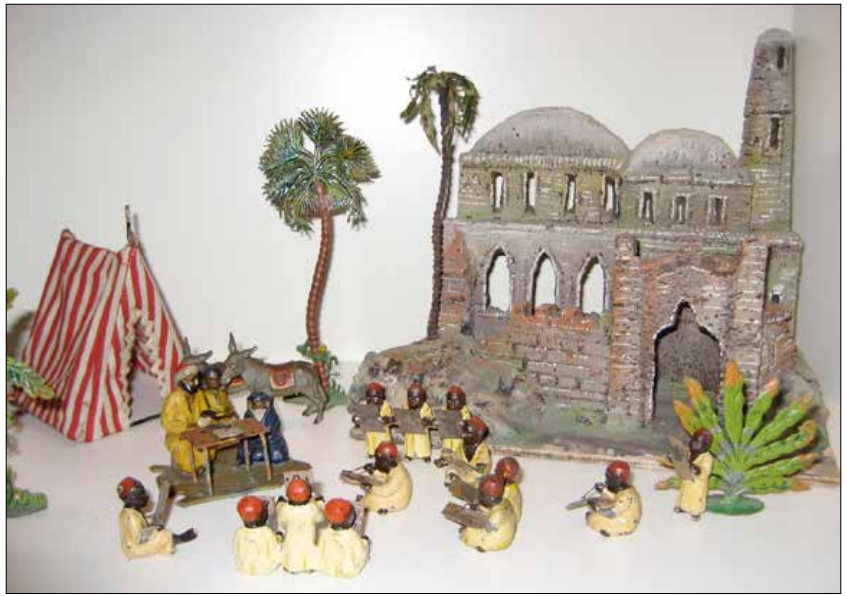
C.B.G. Mignot Diorama
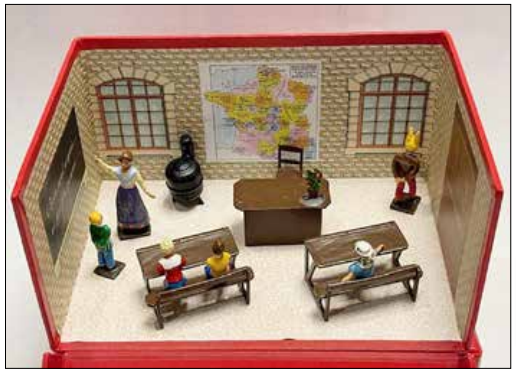
This schoolroom diorama is one of many offerings by Mignot. CBG Mignot is the combination of several 19th century French firms including Lucotte. Mignot is, of course, best known for its exceptional painted, solid cast military lead figures, primarily in 54mm.
Among the most recent additions to its line in the last 30 years are its “Little Diorama Box” series that includes ten “children” scenes. These boxes range from “fishing” to “jazz band”. All are in 54mm in the same style drop-front boxes with appropriate printed backgrounds.
This box titled “L’Ecole”, “The School”, includes a woman teacher as seen in other maker’s sets. She is in the left side of the box pointing to a blackboard instructing a boy in front of her. On the opposite side of the diorama is a contrasting boy in a dunce hat. Filling the center of the diorama wall is a great map of France. And in front of that are two desks with three studious well-behaved students; earlier sets had two seated children. It is the boys who are in dunce hats, that attest that these remain well behaved co-ed schoolrooms. This recent version of the set has Mignot painting that is less realistic, even a bit comical.
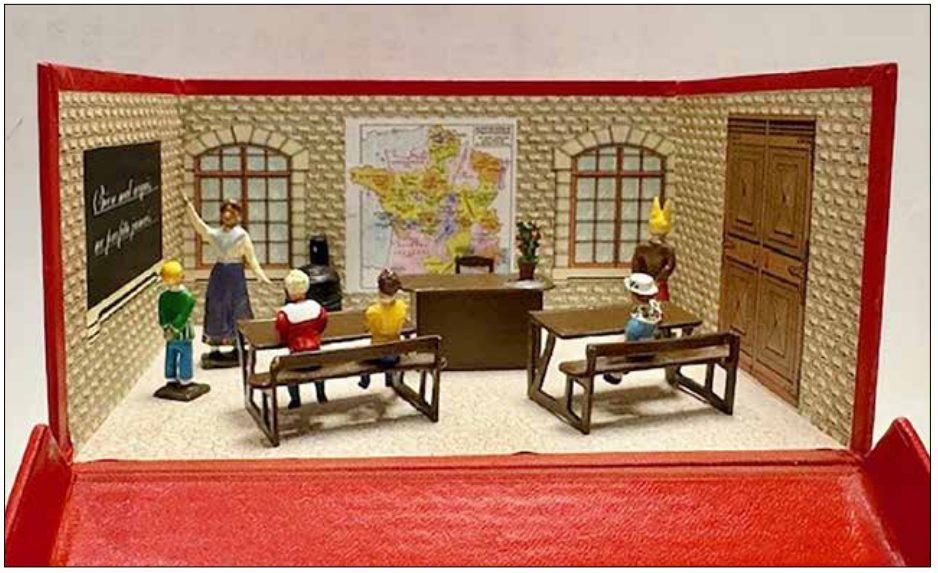
Pixi Diorama
Alexis Poliakoff began making Pixi Figures for sale in the 1980s. This broad range was the subject of a special exhibition at the Maillol Paris Museum in 2012-2013. A book about his line of figures is entitled “A World of its Own”. This suggests the scope and somewhat fanciful sculpting of Poliakoff’s work. These 54mm solid cast lead figures were sold as singles and in diorama style boxes.
Like the Mignot schoolroom box, Pixi dioramas have illustrated backgrounds. Unlike Mignot’s, Pixi’s is a more dramatic and better scaled painted scene. On the left wall of Pixi’s is a blackboard with writing in French. The center is two large windows and a windowed door that shows a village scene. The right wall paints a tall cabinet topped by a globe next to a clock with a Map of France on the wall. The types of cast figures common to the other French sets probably shows the historical accuracy of both dioramas. The figures and furniture almost exactly replicate the contents of Mignot’s box. The exception is that Pixi are almost comical. This set is a wonderful surprise shared by Gisbert Freber.
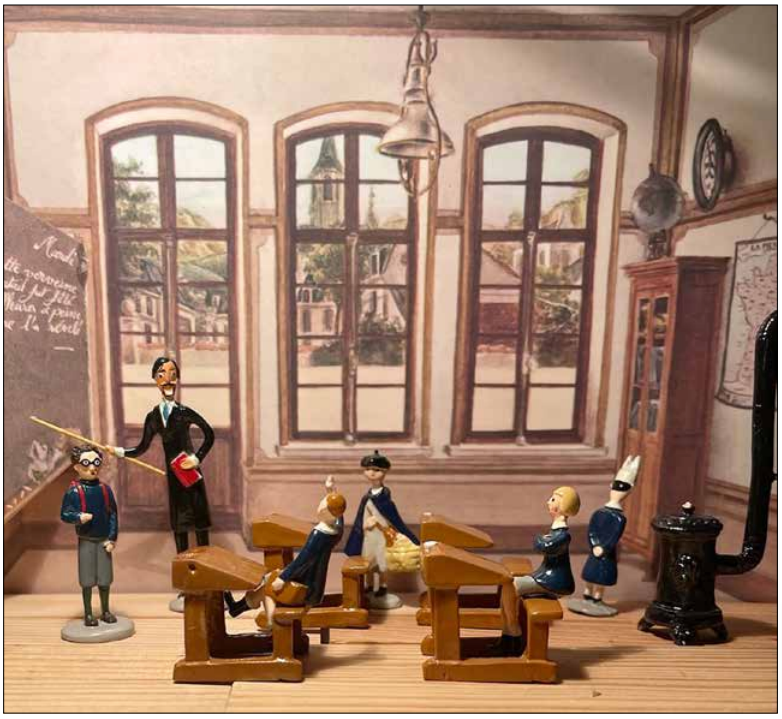
Crescent “School Days” Sets
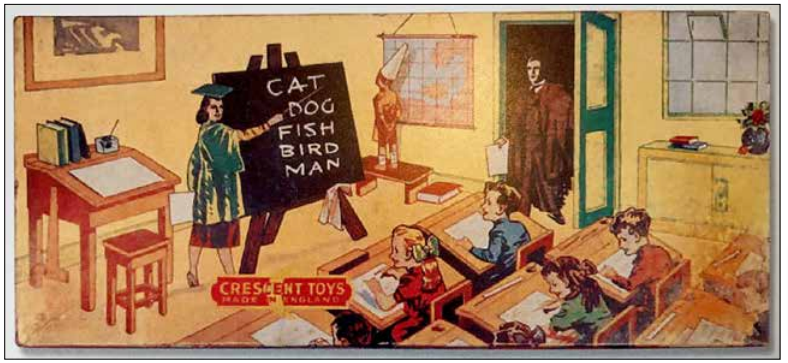
The British company Crescent made an extremely wide range of hollowcast toy soldiers and civilians from approximately 1922 to 1964. Their 1949 catalog lists two box types of “school days” sets. Their smaller cardboard box contained tissue wrapped items: a blackboard on a cast support stand, a woman teacher next to her desk, three students at their desks, and a boy in a dunce cap. That box cover shows far more excitement than its contents reveal. Most interesting is a piece of unused box cover art showing an even more frantic scene. Perhaps this unused illustration was intended for their large box “display set”. This set employs Crescent’s standard multi-image lid. Those sets substitute a school nurse and male teacher for the teacher’s desk and eliminates the Dunce altogether; there is even less excitement there. Although beyond the scope of this article, there are other Crescent school related figures; particularly important is a Crescent crossing Warden (guard) holding an exceptionally rare
cardboard stop sign. All the figures are 54mm.
All information on Crescent is with thanks to Norman Joplin with photographer Philip Dean from their
book Hollow-Cast Civilian Toy Figures. It is simply a spectacular all-color resource book picturing
thousands of civilian items from dozens of makers.
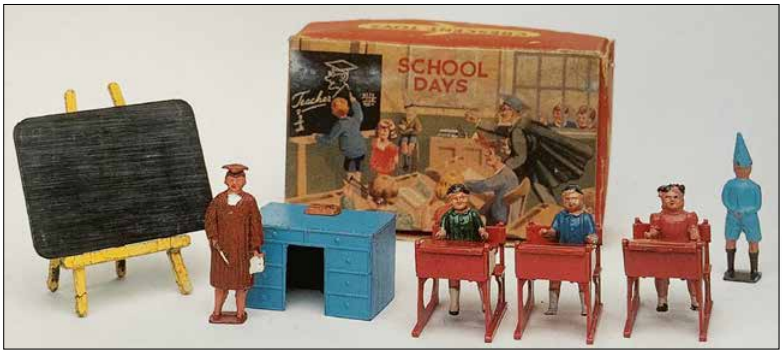
French Girls Schoolroom

This is certainly a French classroom. The underside of the woman teacher’s cast lead desk is marked: Depose France. On a tin tripod is a glued paper map of France with all the writing in French spelling. This set is made by one of several makers known as “French Dimestore”, in this case Jouet Fondu (JF). The teacher and the eight students are 54mm hollowcast. These girls are seated two at each cast metal desk. A male teacher and pupils were also produced.
The girls are crisply painted in single color clothing with a few details. Their dresses extend below the knee, but the castings would have allowed them to be painted in different length dresses or even as boys in shirts and shorts. These girls are, however, an accurate representation of many single sex classrooms before or after WWII.
From many of these and more makers there are dozens of single figures of teachers, and school kids, and kids at play, probably “after school”. So maybe another article or two should be in the works. I know there is at least one composition set and a couple of 1950’s plastic ones and I’m not sure what else. If you’d like to contribute or just talk, email us at steveandjo. [email protected]
Again thanks to Markus Grein, Norman Joplin and Rob Wilson; each gave important assistance with information and photos.
